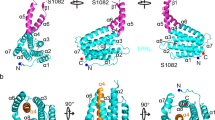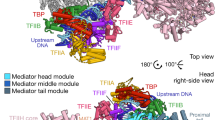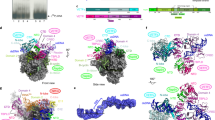Abstract
The human Mediator coactivator complex interacts with many transcriptional activators and facilitates recruitment of RNA polymerase II to promote target gene transcription. The MED25 subunit is a critical target of the potent herpes simplex 1 viral transcriptional activator VP16. Here we determine the solution structure of the MED25 VP16-binding domain (VBD) and define its binding site for the N-terminal portion of the VP16 transactivation domain (TADn). A hydrophobic furrow, formed by a β-barrel and two α-helices in MED25 VBD, interacts tightly with VP16 TADn. Mutations in this furrow prevent binding of VP16 TAD to MED25 VBD and interfere with the ability of overexpressed MED25 VBD to inhibit VP16-dependent transcriptional activation in vivo. This detailed molecular understanding of transactivation by the benchmark activator VP16 could provide important insights into viral and cellular gene activation mechanisms.
This is a preview of subscription content, access via your institution
Access options
Subscribe to this journal
Receive 12 print issues and online access
$189.00 per year
only $15.75 per issue
Buy this article
- Purchase on Springer Link
- Instant access to full article PDF
Prices may be subject to local taxes which are calculated during checkout





Similar content being viewed by others
References
Roizman, B. & Knipe, D. in Fundamental Virology, 4th edn (eds. Knipe, D.M. et al.) 1123–1183 (Lippincott-Raven, 2001).
Triezenberg, S.J., Kingsbury, R.C. & McKnight, S.L. Functional dissection of VP16, the trans-activator of herpes simplex virus immediate early gene expression. Genes Dev. 2, 718–729 (1988).
Greaves, R. & O'Hare, P. Separation of requirements for protein-DNA complex assembly from those for functional activity in the herpes simplex virus regulatory protein Vmw65. J. Virol. 63, 1641–1650 (1989).
Ghosh, S., Toth, C., Peterlin, B.M. & Seto, E. Synergistic activation of transcription by the mutant and wild-type minimal transcriptional activation domain of VP16. J. Biol. Chem. 271, 9911–9918 (1996).
Näär, A.M., Lemon, B.D. & Tjian, R. Transcriptional coactivator complexes. Annu. Rev. Biochem. 70, 475–501 (2001).
Boyer, T.G., Martin, M.E., Lees, E., Ricciardi, R.P. & Berk, A.J. Mammalian Srb/Mediator complex is targeted by adenovirus E1A protein. Nature 399, 276–279 (1999).
Näär, A.M., Taatjes, D.J., Zhai, W., Nogales, E. & Tjian, R. Human CRSP interacts with RNA polymerase II CTD and adopts a specific CTD-bound conformation. Genes Dev. 16, 1339–1344 (2002).
Kornberg, R.D. Mediator and the mechanism of transcriptional activation. Trends Biochem. Sci. 30, 235–239 (2005).
Conaway, R.C., Sato, S., Tomomori-Sato, C., Yao, T. & Conaway, J.W. The mammalian Mediator complex and its role in transcriptional regulation. Trends Biochem. Sci. 30, 250–255 (2005).
Malik, S. & Roeder, R.G. Dynamic regulation of pol II transcription by the mammalian Mediator complex. Trends Biochem. Sci. 30, 256–263 (2005).
Mittler, G. et al. A novel docking site on Mediator is critical for activation by VP16 in mammalian cells. EMBO J. 22, 6494–6504 (2003).
Yang, F., DeBeaumont, R., Zhou, S. & Naar, A.M. The activator-recruited cofactor/Mediator coactivator subunit ARC92 is a functionally important target of the VP16 transcriptional activator. Proc. Natl. Acad. Sci. USA 101, 2339–2344 (2004).
Benedit, P. et al. PTOV1, a novel protein overexpressed in prostate cancer containing a new class of protein homology blocks. Oncogene 20, 1455–1464 (2001).
Ikeda, K., Stuehler, T. & Meisterernst, M. The H1 and H2 regions of the activation domain of herpes simplex virion protein 16 stimulate transcription through distinct molecular mechanisms. Genes Cells 7, 49–58 (2002).
Langlois, C. et al. NMR structure of the complex between the Tfb1 subunit of TFIIH and the activation domain of VP16: structural similarities between VP16 and p53. J. Am. Chem. Soc. 130, 10596–10604 (2008).
Uesugi, M., Nyanguile, O., Lu, H., Levine, A.J. & Verdine, G.L. Induced alpha helix in the VP16 activation domain upon binding to a human TAF. Science 277, 1310–1313 (1997).
Kobayashi, N. et al. DA-complex assembly activity required for VP16C transcriptional activation. Mol. Cell. Biol. 18, 4023–4031 (1998).
Hayashi, F. et al. Human general transcription factor TFIIB: conformational variability and interaction with VP16 activation domain. Biochemistry 37, 7941–7951 (1998).
Hall, D.B. & Struhl, K. The VP16 activation domain interacts with multiple transcriptional components as determined by protein-protein cross-linking in vivo. J. Biol. Chem. 277, 46043–46050 (2002).
Kretzschmar, M., Kaiser, K., Lottspeich, F. & Meisterernst, M. A novel mediator of class II gene transcription with homology to viral immediate-early transcriptional regulators. Cell 78, 525–534 (1994).
Ge, H. & Roeder, R.G. Purification, cloning, and characterization of a human coactivator, PC4, that mediates transcriptional activation of class II genes. Cell 78, 513–523 (1994).
Jonker, H.R., Wechselberger, R.W., Boelens, R., Folkers, G.E. & Kaptein, R. Structural properties of the promiscuous VP16 activation domain. Biochemistry 44, 827–839 (2005).
Laskowski, R.A., Rullmannn, J.A., MacArthur, M.W., Kaptein, R. & Thornton, J.M. AQUA and PROCHECK-NMR: programs for checking the quality of protein structures solved by NMR. J. Biomol. NMR 8, 477–486 (1996).
Holm, L. & Sander, C. Protein structure comparison by alignment of distance matrices. J. Mol. Biol. 233, 123–138 (1993).
Ariyoshi, M. & Schwabe, J.W. A conserved structural motif reveals the essential transcriptional repression function of Spen proteins and their role in developmental signaling. Genes Dev. 17, 1909–1920 (2003).
Walker, J.R., Corpina, R.A. & Goldberg, J. Structure of the Ku heterodimer bound to DNA and its implications for double-strand break repair. Nature 412, 607–614 (2001).
Näär, A.M. et al. Composite co-activator ARC mediates chromatin-directed transcriptional activation. Nature 398, 828–832 (1999).
Reibarkh, M., Malia, T.J. & Wagner, G. NMR distinction of single- and multiple-mode binding of small-molecule protein ligands. J. Am. Chem. Soc. 128, 2160–2161 (2006).
Yang, M., Hay, J. & Ruyechan, W.T. Varicella-zoster virus IE62 protein utilizes the human mediator complex in promoter activation. J. Virol. 82, 12154–12163 (2008).
Roupelieva, M. et al. Kaposi's sarcoma–associated herpesvirus Lana-1 is a major activator of the serum response element and mitogen-activated protein kinase pathways via interactions with the Mediator complex. J. Gen. Virol. 91, 1138–1149 (2010).
Yamamoto, S., Eletsky, A., Szyperski, T., Hay, J. & Ruyechan, W.T. Analysis of the varicella-zoster virus IE62 N-terminal acidic transactivating domain and its interaction with the human mediator complex. J. Virol. 83, 6300–6305 (2009).
Leal, A. et al. Identification of the variant Ala335Val of MED25 as responsible for CMT2B2: molecular data, functional studies of the SH3 recognition motif and correlation between wild-type MED25 and PMP22 RNA levels in CMT1A animal models. Neurogenetics 10, 275–287 (2009).
Wysocka, J. & Herr, W. The herpes simplex virus VP16-induced complex: the makings of a regulatory switch. Trends Biochem. Sci. 28, 294–304 (2003).
Holm, L. Unification of protein families. Curr. Opin. Struct. Biol. 8, 372–379 (1998).
Harper, S.M., Neil, L.C. & Gardner, K.H. Structural basis of a phototropin light switch. Science 301, 1541–1544 (2003).
Takeuchi, K., Ng, E., Malia, T.J. & Wagner, G. 1-13C amino acid selective labeling in a 2H15N background for NMR studies of large proteins. J. Biomol. NMR 38, 89–98 (2007).
Ferentz, A.E. & Wagner, G. NMR spectroscopy: a multifaceted approach to macromolecular structure. Q. Rev. Biophys. 33, 29–65 (2000).
Hiller, S., Ibraghimov, I., Wagner, G. & Orekhov, V.Y. Coupled decomposition of four-dimensional NOESY spectra. J. Am. Chem. Soc. 131, 12970–12978 (2009).
Gardner, K.H. & Kay, L.E. Production and incorporation of 15N, 13C, 2H (1H- δ1 methyl) isoleucine into proteins for multidimensional NMR studies. J. Am. Chem. Soc. 119, 7599–7600 (1997).
Delaglio, F. et al. NMRPipe a Multidimensional Spectra Processing System Based on UNIX Pipes. J. Biomol. NMR 6, 277–293 (1995).
Keller, R.L.J. The Computer Aided Resonance Assignment Tutorial (Cantina Verlag, 2004).
Herrmann, T., Güntert, P. & Wüthrich, K. Protein NMR structure determination with automated NOE-identification in the NOESY spectra using the new software ATNOS. J. Biomol. NMR 24, 171–189 (2002).
Shen, Y., Delaglio, F., Cornilescu, G. & Bax, A. TALOS+: a hybrid method for predicting protein backbone torsion angles from NMR chemical shifts. J. Biomol. NMR 44, 213–223 (2009).
Brünger, A.T. et al. Crystallography & NMR system: A new software suite for macromolecular structure determination. Acta Crystallogr. D Biol. Crystallogr. 54, 905–921 (1998).
Gouet, P., Courcelle, E., Stuart, D.I. & Metoz, F. ESPript: analysis of multiple sequence alignments in PostScript. Bioinformatics 15, 305–308 (1999).
Bhattacharya, A., Tejero, R. & Montelione, G.T. Evaluating protein structures determined by structural genomics consortia. Proteins 66, 778–795 (2007).
Acknowledgements
We thank M. Oberer for initial NMR data collection, R. Rodriguez for critical advice on designing biochemical experiments, K. Edmonds for critical reading and Python script writing, S. Hiller and V. Orekhov for advice and assistance with nonlinear-sampling NMR data collection and processing, and H. Arthanari for advice on NMR data collection and manuscript editing. We are very grateful to M. Sattler and E. Vojnic of the Technical University of Munich for critical discussion of unpublished data. We are also thankful for H.C. Seou's assistance with DNA cloning procedures and A. Koglin for help with CNS calculations. A.G.M. was partially supported by a Deutscher Akademischer Austausch Dienst postdoctoral fellowship. P.S. was funded by the Human Frontier Science Program Organization long-term fellowship LT00686/2004-C. The work was supported by US National Institutes of Health grants CA127990 (G.W. and A.M.N.), GM47467 and EB002026 (G.W.) and GM071449 (A.M.N.).
Author information
Authors and Affiliations
Contributions
A.G.M. prepared protein samples, recorded and analyzed NMR data, calculated the structure, designed the MED25 VBD mutants and co-wrote the paper; M.K. generated point mutations, did pulldown assays and assisted with transcription assays; T.Y. did transcription assays; R.E.L. assisted with transcription assays, data interpretation and writing of the paper; K.T. and P.S. cloned the original construct, collected initial NMR data, obtained preliminary assignment, and assisted with editing and writing the paper; Z.-Y.J.S. assisted in recording NMR data, data analysis and structure calculation; A.M.N. and G.W. initiated the project, helped design experiments, advised on data collection and interpretation, and participated in writing and editing the manuscript.
Corresponding authors
Ethics declarations
Competing interests
The authors declare no competing financial interests.
Supplementary information
Supplementary Text and Figures
Supplementary Figures 1–9 and Supplementary Table 1 (PDF 9126 kb)
Rights and permissions
About this article
Cite this article
Milbradt, A., Kulkarni, M., Yi, T. et al. Structure of the VP16 transactivator target in the Mediator. Nat Struct Mol Biol 18, 410–415 (2011). https://doi.org/10.1038/nsmb.1999
Received:
Accepted:
Published:
Issue Date:
DOI: https://doi.org/10.1038/nsmb.1999
This article is cited by
-
Regulation of the RNA polymerase II pre-initiation complex by its associated coactivators
Nature Reviews Genetics (2023)
-
The Mediator complex as a master regulator of transcription by RNA polymerase II
Nature Reviews Molecular Cell Biology (2022)
-
Redox regulation of PEP activity during seedling establishment in Arabidopsis thaliana
Nature Communications (2018)
-
Transcription regulation by the Mediator complex
Nature Reviews Molecular Cell Biology (2018)
-
The Mediator complex: a central integrator of transcription
Nature Reviews Molecular Cell Biology (2015)



